Meltdown & Spectre: Analyzing Performance Impacts on Intel's NUC7i7BNH
by Ganesh T S on March 23, 2018 4:15 PM EST- Posted in
- Systems
- Spectre
- Benchmarks
- Meltdown
BAPCo and Futuremark Benchmarks
BAPCo's SYSmark 2014 SE is an application-based benchmark that uses real-world applications to replay usage patterns of business users in the areas of office productivity, media creation and data/financial analysis. In addition, it also addresses the responsiveness aspect which deals with user experience as related to application and file launches, multi-tasking etc. Scores are meant to be compared against a reference desktop (the SYSmark 2014 SE calibration system in the graphs below). While the SYSmark 2014 benchmark used a Haswell-based desktop configuration, the SYSmark 2014 SE makes the move to a Lenovo ThinkCenter M800 (Intel Core i3-6100, 4GB RAM and a 256GB SATA SSD). The calibration system scores 1000 in each of the scenarios. A score of, say, 2000, would imply that the system under test is twice as fast as the reference system.
We see that the patching does have an impact on the performance. It ranges from around 5% for the Office Productivity scenario to around 10% for the Responsiveness metric.
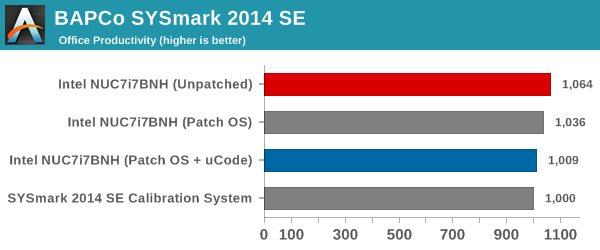
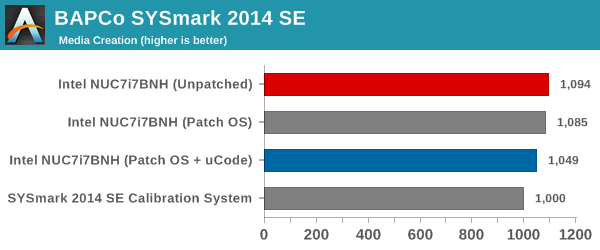
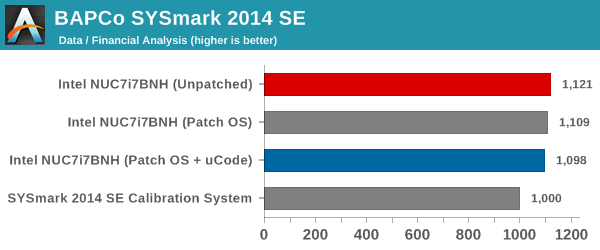
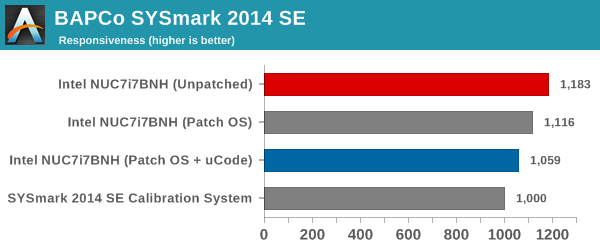
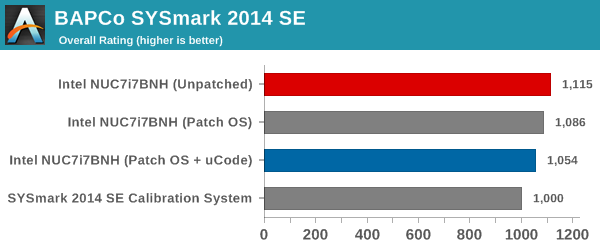
SYSmark 2014 SE also adds energy measurement to the mix. We see that the patched system, despite being slower, consumes lower energy for the completion of the tasks.


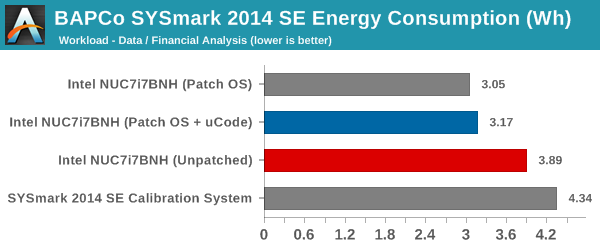
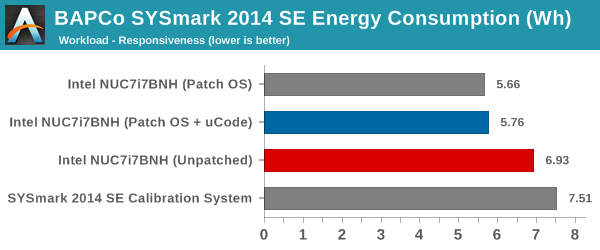

Futuremark PCMark 10
UL's PCMark 10 evaluates computing systems for various usage scenarios (generic / essential tasks such as web browsing and starting up applications, productivity tasks such as editing spreadsheets and documents, gaming, and digital content creation). We benchmarked the configurations with the PCMark 10 Extended profile and recorded the scores for various scenarios. These scores are heavily influenced by the CPU and GPU in the system, though the RAM and storage device also play a part. The power plan was set to Balanced for all the PCs while processing the PCMark 10 benchmark.
Similar to SYSmark 2014 SE, we see performance impacts in all the PCMark 10 scenarios also. For example, the Essentials workload score for the fully patched system is around 6.5% lower than the unpatched system. The gaming workload doesn't seem to be affected much by the patching, though. The overall score is around 2.3% lower.
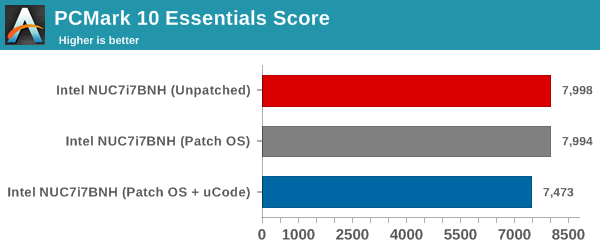
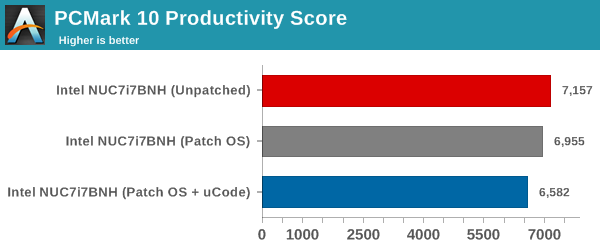
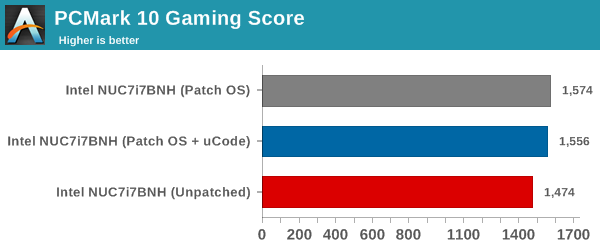

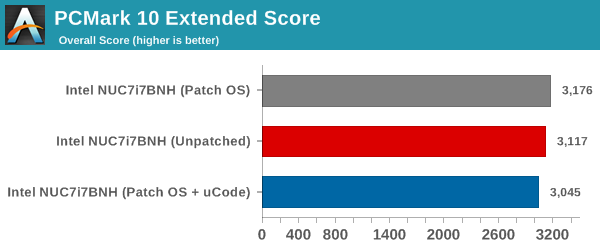
Futuremark PCMark 8
We continue to present PCMark 8 benchmark results (as those have more comparison points) while our PCMark 10 scores database for systems grows in size. PCMark 8 provides various usage scenarios (home, creative and work) and offers ways to benchmark both baseline (CPU-only) as well as OpenCL accelerated (CPU + GPU) performance. We benchmarked select PCs for the OpenCL accelerated performance in all three usage scenarios. Since these scores are heavily influenced by the CPU in the system, it is not surprising to see a performance impact. The patched configuration, on average, scores around 2% lower than the unpatched one.
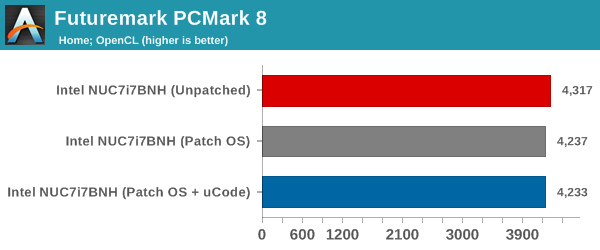
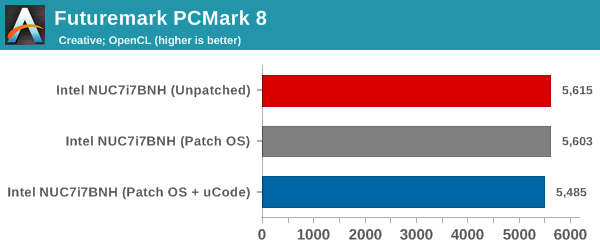
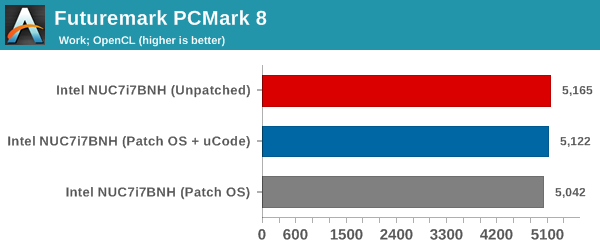
Miscellaneous Futuremark Benchmarks
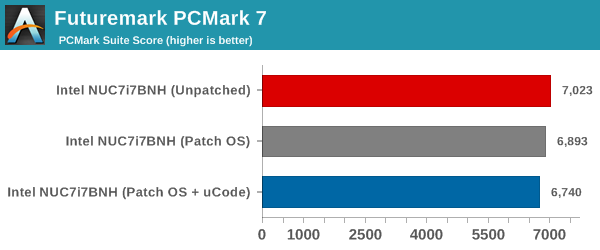
PCMark 7's PCMark Suite shows a 4% performance loss.
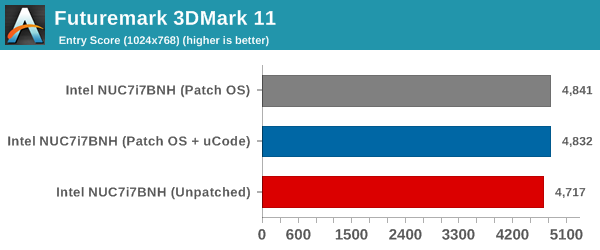
3DMark 11's entry level score and 3DMark 2013's Cloud Gate score actually end up better after the patch, but, 3DMark 2013's Ice Storm score shows a performance loss of more than 13%.
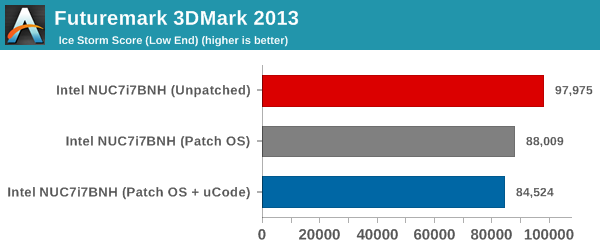
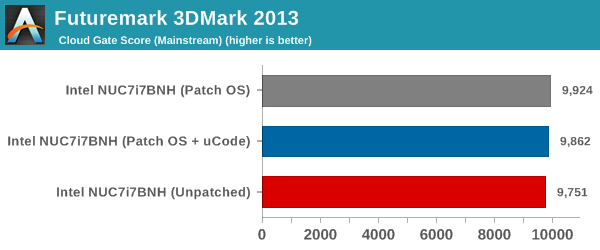
Futuremark PCMark 8 Storage Bench
PCMark 8 has a storage bench where certain common workloads such as loading games and document processing are replayed on the target drive. Results are presented in two forms, one being a benchmark number and the other, a bandwidth figure. We ran the PCMark 8 storage bench on the ADATA NVMe SSD in all the configurations.
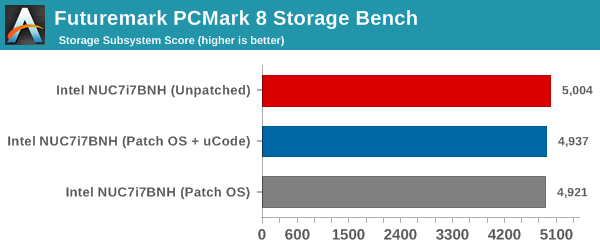
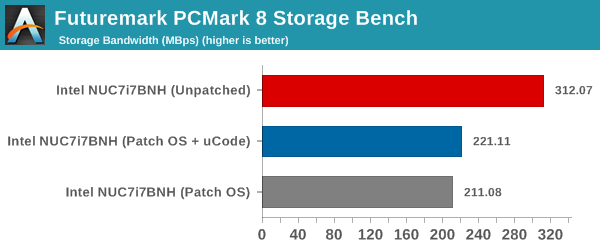
While the absolute score is just around 1.3% lower for the patched configuration, the storage bandwidth is around 29% worse. This significant performance loss is partly due to the NVMe drive performance now being CPU bound. It is highly likely that SATA drives will not experience such a drastic performance loss due to the patching.










83 Comments
View All Comments
chuychopsuey - Friday, March 23, 2018 - link
Wow! That's pretty significant. Looks like it takes you a generation or two backwards.Samus - Saturday, March 24, 2018 - link
The real damage comes for people with NVMe SSD's or other CPU-centric PCIe hardware. 29% performance drop...wow.III-V - Saturday, March 24, 2018 - link
On a single benchmark.You might need to see an optometrist.
Samus - Sunday, March 25, 2018 - link
Optometrist, no. Optimist, yes.umano - Sunday, March 25, 2018 - link
I want to be optimist, this is not a very powerful cpu "This significant performance loss is partly due to the NVMe drive performance now being CPU bound" so maybe on more powerful cpu this % will be lower... I hope solinuxgeex - Monday, March 26, 2018 - link
yes but people with high-end CPUs will tend to have even faster drives, or RAID, or Optane as a disk cache, and I've seen benchmarks where Optane performance dropped >40% on i9. Desktop users won't feel this very much but others who have been paying 300% more for 25% more performance for scale-up business logic are crying.iter - Monday, March 26, 2018 - link
Ultra high performance is only required in workstations. Workstations are used for important work. It is best to keep such systems offline. No need for antivirus, firewall, updating, patching and all that stuff that impedes performance and introduces downtime.The maxima among professionals is "if it works don't touch it". We are well past the point where it is worth keeping everything up to date with the latest versions. It's been a while since version updates were about making things better for the user, they are mostly about making things better for the big software corporations.
Use a separate low end system for internet. With nothing important on it.
PeachNCream - Monday, March 26, 2018 - link
I can't think of any situations where I've seen professional workstations that are intentionally kept offline and deprived of software updates. Perhaps that's something that would happen in a small business or SOHO where the end user is also her own IT support and might make such an odd decision, but as a client to a company using that sort of policy, I'd be concerned they were making a larger error of judgement in adhering to automotive or mechanical engineering wisdom of the 20th Century.iter - Monday, March 26, 2018 - link
That same wisdom that has resulted in countless security breaches and the privacy of billions of people violated.Thanks but no thanks. The "standards" are too low.
The lack of internet connectivity doesn't in any way impede dedicated support personnel from supporting. Those people are supposed to know their biz, not google about it.
The only error in judgement you should be concerned at the time is your own. A system that is dedicated to doing work has no job being connected to the internet. There is absolutely no good reason to update it as long as it operates property. The update will add no value, will only introduce downtime, and is likely to break stuff up.
PeachNCream - Monday, March 26, 2018 - link
Despite those strongly expressed thoughts, there are very few workstations that are running as stand-alone systems that don't get vendor software updates.